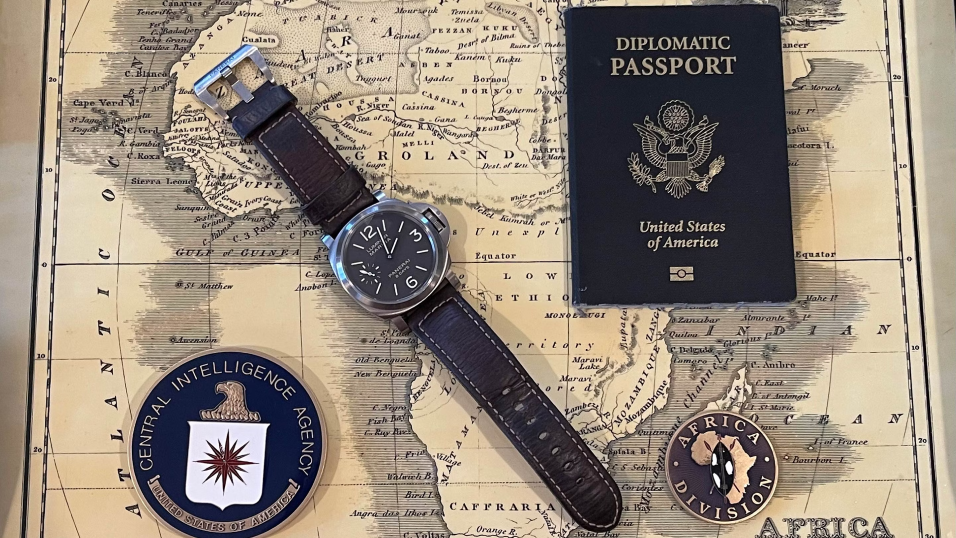In-Depth: A Former CIA Case Officer Reveals The Surprising Connection Between Watches and Espionage
Luxury timepieces play a significant role in the murky world of spycraft – just not the way they’re portrayed in Hollywood.
[Editors’ Note: The author of this story, a former undercover officer for the CIA, has asked to remain anonymous.]
He’s late.
It’s pouring and I’m standing in a dark alley in a North African capital at the height of an ongoing military coup, waiting for my source.
I nervously glance down at my titanium Panerai Luminor Marina 8 Day. The still-glowing hands indicate it is 2:01:15 AM. If the asset, a foreign intelligence officer who is taking great risk to spy for the United States, does not arrive in the next 45 seconds, I’ll have to disappear into the night, missing a crucial opportunity to collect intelligence of strategic importance to the United States government.
As a CIA Case Officer operating undercover for almost a decade, my job was to recruit spies and steal secrets. At the core of this trade was clandestinely handling assets, or “spies,” to securely collect information to further United States’ interests. This generally occurred late at night in less-than-ideal locations, including dark alleys and the types of hotels that charge by the hour.
The scene in this story was a relatively routine night and something I spent years training for, rehearsing and perfecting throughout the Middle East and Africa. While the location and the mission changed over the years, the one thing that remained the same was the presence of a reliable timepiece on my wrist.
Senses heightened, I scan the alley and again check the time on my Luminor Marina 8 Days Titanio PAM 564. Panerai originally developed the watch in partnership with Rolex for the use of the Italian Frogmen – the elite maritime special operations unit that served in World War II. The large, luminescent numerals ensured legibility in murky water, and they’re proving legitimately useful all these years later in the muddy alleyway.
15 seconds to go.
Mentally running through the contingency plan, I ready myself for my long Surveillance Detection Route to my bed-down location. I’m calm, but the inevitable second-guessing sets in. Is this a setup? Is the asset in trouble? Will I be swarmed by police as I leave the alley? Will my cover story hold up under intense interrogation?
Finally, a dark figure enters the alley with a smile on his face.
Just in the nick of time.
In the world of espionage, time matters. During an intelligence operation, mere seconds can mean the difference between life and death, imprisonment or (potentially worse) failing to collect strategic intelligence. So, it’s no surprise that the intelligence business – foreign intelligence collection, covert action and counterintelligence – is inextricably linked to reliable, even luxury, timepieces.
When I started Watches of Espionage, an Instagram page dedicated to the intersection of timepieces and spycraft, I wanted to challenge the popular notions of James Bond driving an Aston Martin DB5, a Rolex Submariner reference 6538 on his wrist. Or of Jason Bourne scaling the U.S. Embassy in Zurich wearing a TAG Heuer Link Chronograph. In reality, the utility of watches in the intelligence business is more mundane. Watches are tools. They are used to accomplish clandestine missions, build relationships, and complete operational tasks. In a world where GPS-enabled electronic devices pose an operational security risk, analog watches are even used for their original purpose: To tell time.
In the halls of “Langley” – the colloquial term for CIA Headquarters – the ties of watches to the Intelligence Community are evident. The CIA is composed of tribes, and timepieces are subtle indications of an officer’s tribe or identity. Burly paramilitary officers with beards are seen wearing Panerai, Sangin Instruments, and Bremont. European officers are drawn to dressier Jaeger-LeCoultre and IWC pieces to match fine tailored suits, while officers who serve in the Middle East and Africa may wear Breitling or Rolex, with the most fortunate ones showing the crest of a Middle Eastern nation.
There’s also the so-called “war zone watch.” While a government salary does not support an extensive watch collection, when officers deploy to war zones for an extended period, their pay can almost double while their personal expenses are minimal. After returning from Iraq, Afghanistan, or one of the undeclared expeditionary locations, many officers take a portion of their savings and purchase a watch to discreetly commemorate the accomplishment, often the ubiquitous Rolex Submariner or Omega Seamaster, no doubt a subtle nod to Bond.
When collecting Human Intelligence (HUMINT), it is the job of a Case Officer to build a relationship with a foreign government official or member of a terrorist group and manipulate them to spy against their own organization or country. It takes time to build this level of trust, and operational gifts can go a long way toward earning it. A luxury timepiece is an ideal gift; it’s immediately recognizable and it’s something that the agent can wear as a constant reminder of the friendship with the Case Officer and thus the greater relationship with the US Government.
Further, the soon-to-be agent’s acceptance of an expensive gift from an American official is a strong indication that the individual is willing to move in the direction of a clandestine relationship. If he or she accepts the watch, the Case Officer must work with the target to develop an appropriate cover story regarding the watch’s origin.
Get More Articles Like This in Your Inbox
We're constantly creating great content like this. So, why not get it delivered directly to your inbox? By subscribing you agree to our Privacy Policy but you can unsubscribe at any time.
















